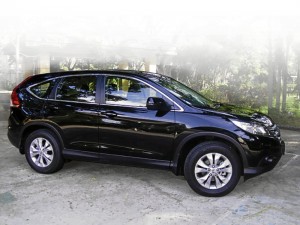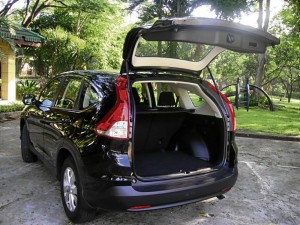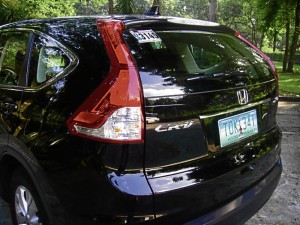Ever since Honda Motor Co. introduced the CR-V on the market in 1995, it has been an outstanding success in 160 markets worldwide. The “Comfortable Run-about Vehicle” of Japan’s third-largest auto maker outsells its competitors in the car-based compact crossover segment. On the streets of Metro Manila, it seems that every other vehicle is a CR-V belonging to either the first (1995-2001), second (2002-2006) or third (2007-2011) generation, attesting to its popularity, longevity and high resale value.
So are you surprised that in designing the 2012/fourth iteration of the CR-V, Honda stuck to the same winning formula? Except for bigger, wider vertical tail lights, a more curvaceous butt and thicker C-pillars, the exterior looks almost the same as the previous model because of similar projector-type headlights, slatted grille with the “H” badge at center and front bumper-integrated fog lamps.
The same i-VTEC in-line 4 cylinder engines power the newest CR-V: the 2.4-liter DOHC powerplant for the EX 4WD variant and the 2.0-liter SOHC for the LX 2WD variant. Both engines are still mated to a 5-speed automatic transmission (A/T) at a time when the competition has moved up to 6 speeds. The 2.4 EX 4WD is priced at P1.655 million, or P130,000 more than the outgoing 2.4 SX 4WD, maybe partly because the new CR-V units sold here are imported from Japan while Honda’s Thailand factory, flooded last year, is trying to regain full production capacity.
Increased. But don’t jump to the conclusion that everything in the new CR-V is the same as in the old. The peak horsepower of the 2.4 i-VTEC engine has been increased from 170 to 185 ps and max torque upped from 22.2 to 22.4 kg-m. Honda claims that internal friction in the engine has been reduced, the new alternator is more efficient while taller gear ratios have been installed in the A/T to eliminate gear hunting. The real-time 4WD system has been upgraded from a hydraulically controlled to an electronically activated one that is lighter, quicker and seamless in its operation and more efficient in improving fuel economy.
The green Econ button on the dashboard is a new high-tech feature that catches your eye as soon as you get into the driver’s seat. Honda says that when you push the button, it shifts key systems that influence fuel consumption into smart mode. As far as car enthusiasts are concerned, however, the Econ button dulls throttle response and makes the CR-V feel slower and sluggish even in city traffic. The electronically assisted power steering doesn’t help any with its lack of feedback and its numb, artificial feel when you increase your speed.
To some, Honda’s decision to retain the 5-speed A/T may be a minor gripe, but while the fiver works smoothly and promptly, six gear ratios would surely enhance acceleration and improve fuel efficiency even more. As it is, the CR-V 2.4 4WD averages 9.26 km per liter in city traffic and 12.63 km per liter on the highway. These numbers should improve if you’re the type who likes to push the Econ button and see the Eco-coaching Ambient Light around the speedometer turn green, indicating that you are driving efficiently.
Adequate. While the new CR-V’s slightly improved drivetrain and 5-speed A/T may disappoint nitpickers and car buffs, given that neither a turbo option or a common rail direct injection diesel engine is available, for most of us it still delivers adequate power, agility and a smoother, more comfy, quieter ride than its predecessor. The 2012 CR-V is undoubtedly a winner in terms of solid build quality, impeccable fit and finish, interior trim, roominess and conveniences, cargo space and safety features. After all, the CR-V is a family car, not a high-performance sport sedan. The improved fuel economy is already a major point in its favor.
More sound-deadening material throughout the cabin makes the fourth-generation CR-V quieter than before. The cabin looks more refined with softer-to-the-touch materials, more storage bins and cupholders (three in a row between the front seats) and an array of high-tech features as standard equipment in the 2.4 EX variant: two separate multi-info (i-MID) displays—one on the instrument panel and another in the middle of the dash—that integrate audio, fuel economy, lighting setup and Bluetooth; a tilt-and-telescopic steering wheel with audio, i-MID controls and cruise control; USB and AUX-in jacks inside the center console box; dual-zone climate controls.
THE COCKPIT has been totally redesigned but alas, the AT is still 5-speed. PHOTOS BY AIDA SEVILLA-MENDOZA
Although it is shorter and lower in height than the outgoing model, the new CR-V feels bigger and wider inside with well-bolstered seats, plenty of headroom and legroom. The height-adjustable driver’s seat is slightly elevated, giving a commanding view forward and sideward although rearward visibility is hindered by the thick C-pillars. This shortcoming is resolved by the rear back-up camera.
Smooth. The 60/40 split rear seats fold instantly and smoothly when you yank two mechanical levers. With the rear seats folded, cargo volume is increased from 37.2 to 70.9 cubic feet. The rear seats have two seatback angles and the large, easy-to-load cargo bay has a removable tonneau cover.
The safety features include daylight running lights, Vehicle Stability Assist, hill start assist and hands-free telephone (in the 2.4 EX) aside from two airbags, ABS with EBD and Brake Assist, keyless entry with panic button and security alarm system. Strong brakes (ventilated disks up front, drum in disk at the rear) and a suspension system (MacPherson strut up front, double-wishbone at the rear) with more travel and new 17-inch alloy wheels complete the picture.
Bottom line, the CR-V has been redone in a mildly evolutionary rather than a wildly revolutionary manner, but it is still fundamentally satisfying, versatile and pleasant to drive. Although slightly outdated in some aspects, the 4th evolution of the Honda CR-V is supported by a proven best-in-class, value-for-money heritage—and for most of us, that’s more than enough.




